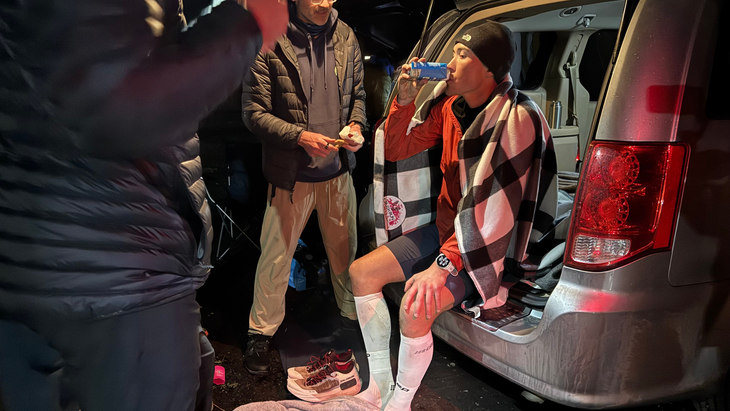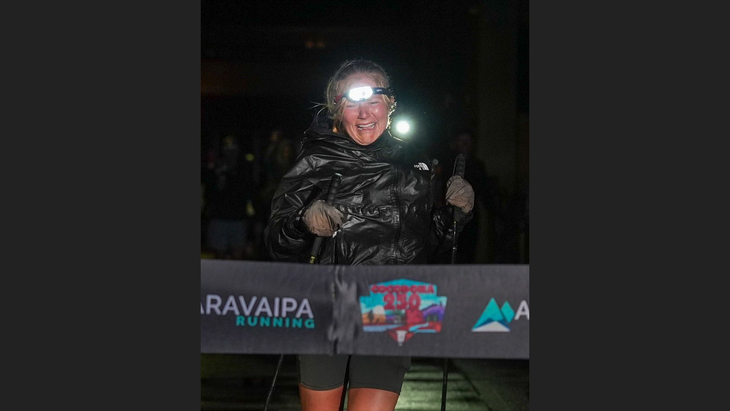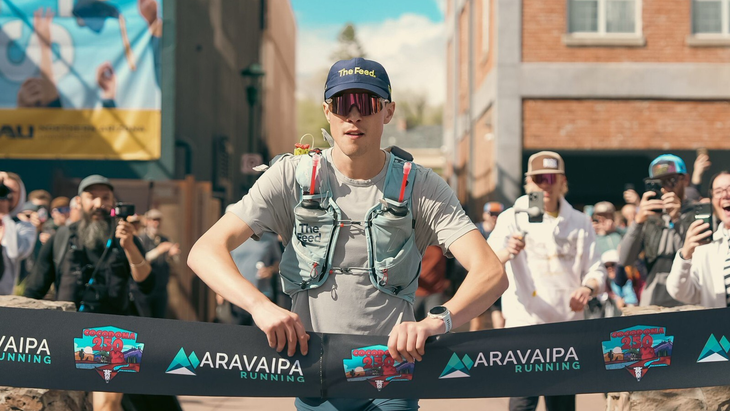“], “filter”: { “nextExceptions”: “img, blockquote, div”, “nextContainsExceptions”: “img, blockquote, a.btn, a.o-button”} }”>
New perk: Easily find new routes and hidden gems, upcoming running events, and more near you. Your weekly Local Running Newsletter has everything you need to lace up!
>”,”name”:”in-content-cta”,”type”:”link”}}”>Subscribe today.
Rachel Entrekin didn’t know she was winning.
The Colorado-based ultrarunner ran into the Dead Horse aid station at 9:35 a.m. on Tuesday, May 6, 28 hours and 134 miles after starting the Cocodona 250. Since setting out from the start line in Black Canyon City, Arizona, at 5 a.m. the previous morning, she and 2023 UTMB winner Courtney Dauwalter had been sparring for top spots in the race.
In the middle of night one, Dauwalter dropped. That left 33-year-old Entrekin in the lead of the women’s race, and third place overall. Her crew could’ve shared that news with her at any point. But it wasn’t until a livestream videographer mentioned her lead that she learned she was the race’s top woman. So into the aid station she came, exclaiming, “How did everybody know but me?”
“We wanted Rachel to run her own race,” said Gus Gibbs, a member of Entrekin’s crew. “Everything was going so well that letting her have her own experience was the best possible outcome.”
Entrekin had plenty of experience with the highs and lows of a 250-mile race, having won last year’s edition. But this moment, just over halfway through, embodies the spirit of her 2025 race. Sure, the Cocodona 250 is a grueling test of endurance and grit. But the real recipe for success, according to both Entrekin and men’s winner Dan Green, is a supportive crew.
Unusual Conditions for an Unusual Race
Ask any runner the best conditions for racing and you’ll likely get similar answers: overcast with temperatures in the 50s. Not typical of May in Arizona.
But just in time for the start of the 2025 Cocodona 250, the clouds rolled in and the mercury dropped. Before the race, 2021 winner and Cocodona legend Michael Versteeg put into words what many racers were feeling: “If there’s a year to go fast, this is it.” Racers set out in scattered precipitation and cool temperatures, conditions that mostly continued for the following three days.
2024 champ Harry Subertas took it out hot, bringing the rest of the field along on a breakneck pace as he averaged 10-minute miles through the first quarter of the race. Around mile 70, Dauwalter took over the lead of the entire race. Behind her, Entrekin and Green bid their time, running steady and whittling down the gap to the leaders.
Twenty-eight-year-old Green came into this race lacking some of the ultra-ultra distance experience of Entrekin, Dauwalter, and other top contenders. In fact, this was his first race over 100 miles. But he had a similar advantage to Entrekin: A tight group of friends who were just as enthusiastic at 2 a.m. as they were at 2 p.m.
Hoots, hollers, and a hearty “Let’s go boys!” greeted Green as he trotted into the Fain Ranch aid station at mile 95.9, his crew seemingly more excited than he was about his overtake of Dauwalter and newfound frontrunner status. Like an F1 pit crew, they got straight to work refueling, recharging his watch, and changing out mud-coated shoes. At 10:30 p.m., Green headed back out into the dark, cold, and mud towards the race’s halfway point. By the next morning, Dauwalter had dropped, and a new runner emerged to challenge his lead.
A Sustained Battle at the Top
“What are they doing?” Green said with a smirk.
He was looking over at South African runner Ryan Sandes and his crew, who had come into the Sedona Posse Grounds aid station (mile 162.3) just three minutes after him. Green was joking around, but quickly turned race mode back on as he slipped on his shoes, downed some final pancakes, and got back out on course. Sandes continued his pursuit seven minutes later.
Seventeen hours after taking the lead, Green was duking it out with 43-year-old Sandes to maintain his position. The two were running close together over the muddy, relatively flat trails of the Verde Valley on the race’s gloomy second day. Entrekin was less than 90 minutes behind in third, in good spirits as she stopped for a quick nap before the steep climb up the aptly-named Hangover Trail out of Sedona.

As the top runners battled physical and mental fatigue, their crews rushed to keep up with their needs. Over 250 miles of racing, runners must take time to rest, change clothes and shoes, eat and drink. But with a lead this tight, every second counted. Teams of dedicated crew members set out arrays of soft flasks, socks, shoes, and snacks, preparing instant mashed potatoes and ramen to ensure that their runners could be in and out as quickly as possible. For Green and Entrekin, this meant sitting down, cracking some jokes, scarfing down food, changing out gear, and heading back out, all within 10-15 minutes.
The Final Push
When she came into view of the Fort Tuthill aid station at mile 214.7, Rachel Entrekin burst into tears. It wasn’t just the imminent hot food and fresh socks that set off her emotions—Entrekin’s parents, Robin and Karen, were standing beside the trail, there to support her on the final day of her race. After wiping her tears, Entrekin headed towards her team’s van, quipping, “Come meet my idiot friends.”
“I’ve already met them, honey, they’re lovely,” Entrekin’s mom Karen responded.

Knowing the race was in its final stages, the mood among the crew was jittery, excited yet still busy providing for the racer’s needs. “I definitely knew it was going to be a special day,” recalled Gibbs, Entrekin’s crew member.
Entrekin had a monumental lead over second place woman Lindsey Dwyer, who was about 30 miles behind. But Entrekin entered Fort Tuthill only six minutes after Edher Ramirez, the new third place runner, had left. Fifty-one hours in, and the runners were still pushing each other.
On the other side of Flagstaff, 23 race miles ahead, Dan Green had widened his lead heading into the race’s final climb. In a sadistic bit of course design, the final 15 miles of the Cocodona 250 involve a 2,400-foot climb and descent up and over 9,301-foot Elden Mountain on rocky, technical single track.
“It was rough. It took a long time. It was hot, because the sun came out, but then it started sleeting, so we got the best of both worlds,” Green said. “Luckily I had my brother with me on that section so he snapped me out of it a couple times.”

Despite this final challenge, Green ran into downtown Flagstaff over an hour ahead of the Cocodona 250 course record, on a course over six miles longer and indisputably harder. He crossed the line in the afternoon sunshine after 58 hours, 47 minutes, and 29 seconds of racing. His brother Fred brought him a Coors Light to celebrate.
The excitement of Green’s crew never diminished, and neither, it seemed, had Green’s spirits.
“I thought initially the coolest thing to come out of the race would be the race itself,” Green said. “But I think it was, in all honesty, running with all my friends. Being able to have that time, and they’ve given so much to be out here and do all the planning.”
In the five hours after Green finished, Ryan Sandes and Edher Ramirez rounded out the podium. But by 8:50 p.m., when Rachel Entrekin’s headlamp lit up the race’s final turn into Heritage Square, it was all about the women’s winner. Over a hundred spectators lined the finish chanting, “Rachel, Rachel, Rachel!”
Entrekin broke the tape in a rush of emotion, and her time of 63:58:15 shattered 2022 winner Annie Hughes’ previous course record of 71:10:22 by over seven hours. It would be nearly 16 hours before Lindsey Dwyer finished as the second woman. But in the meantime, Entrekin was flooded with gratitude, hugging her pacer and parents while her characteristic beaming smile shone out to the cheering crowd.
Anything can happen over three days of racing. For the 2025 Cocodona 250, the ingredients for a fast race overlapped. Cool conditions. A quick early pace. A tight, competitive race at the top. As it turned out, Dan Green, Rachel Entrekin, and their crews were the right people to put it all together.
“I don’t think the perfect race exists, but I think I came close to it,” Entrekin said. “Experience plus weather equals whatever that just was.”








![Every Running World Record Broken (So Far) In 2025! [Updated July 2025] Every Running World Record Broken (So Far) In 2025! [Updated July 2025]](https://i0.wp.com/therunningchannel.com/wp-content/uploads/2024/07/ASSEFA-LONDON-Photo-by-Alex-DavidsonGetty-Images-header.jpg?w=350&resize=350,250&ssl=1)





